Great Tools for Graphite Drawing
- Home
- Drawing Supplies
- Drawing Pencils
Recommended Drawing Pencils for Realistic Drawing (and Pencil Grades Demystified!)
All drawing pencils feel different to solve with, and have unique properties that set how your drawing will look. In that guide I will precede you to the most common pencils used for realistic drawing, discuss the ones I utilisation most often in my lottery tutorials (and why), and commend superiority brands for you to try.
First, to address the elephant in the room: What drawing pencils should you use for realistic draught?
If you are a beginner, I advocate that you starting time with black lead pencils. T hey are some of the smoothest and most easily erasable pencils to draw with, making them excellent for confidence-construction when you're learning to draw.
With some get you may choose to graduate to charcoal pencils, which require more technical skill to utilize in effect, but let their advantages over graphite. Read on to key the differences betwixt graphite and charcoal pencils, the advantages and disadvantages of each, and which brands I recommend. I'll also demystify pencil grades!
Graphite Pencil Pathfinder
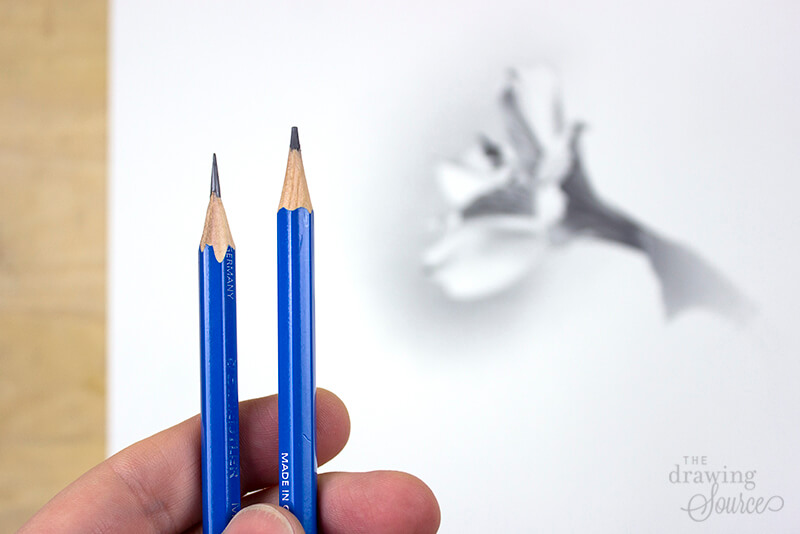 Pictured above: Staedtler Mars Lumograph Graphite Pencils
Pictured above: Staedtler Mars Lumograph Graphite Pencils
Black lead pencils enter a series of 'hardnesses', or 'grades', ranging from 9B (the softest) to 9H (the hardest).
The full wander of graphite drawing pencils looks something like this:
9B, 8B, 7B, 6B, 5B, 4B, 3B, 2B, B, HB, F, H, 2H, 3H, 4H, 5H, 6H, 7H, 8H, 9H
The range varies slightly, dependant on the brand. The grades above (and infra) reflect the range of Staedtler Mars Lumograph graphite pencils (my preferent brand).
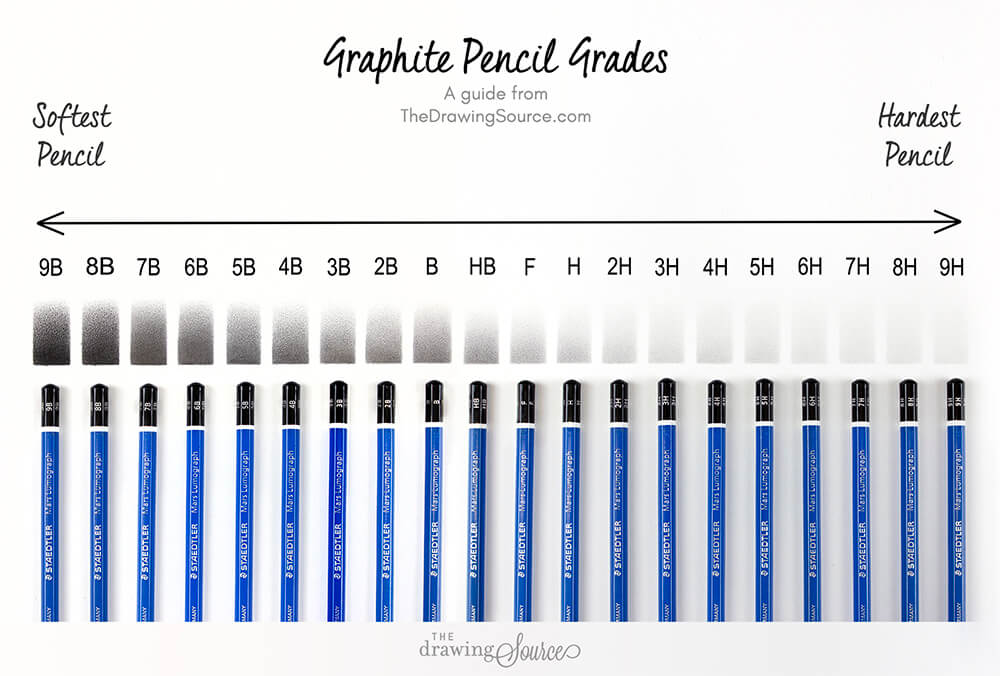 Pictured above: Staedtler Mars Lumograph graphite pencils
Pictured above: Staedtler Mars Lumograph graphite pencils
Why are pencil grades important?
Because the gradation, or the hardness/softness of a pencil, determines the range of values and case of line that the pencil can create. Let's get with the range of values:
If you delineation a full value range (from whiteness to coal black), each pencil class can create a segment of that value range.
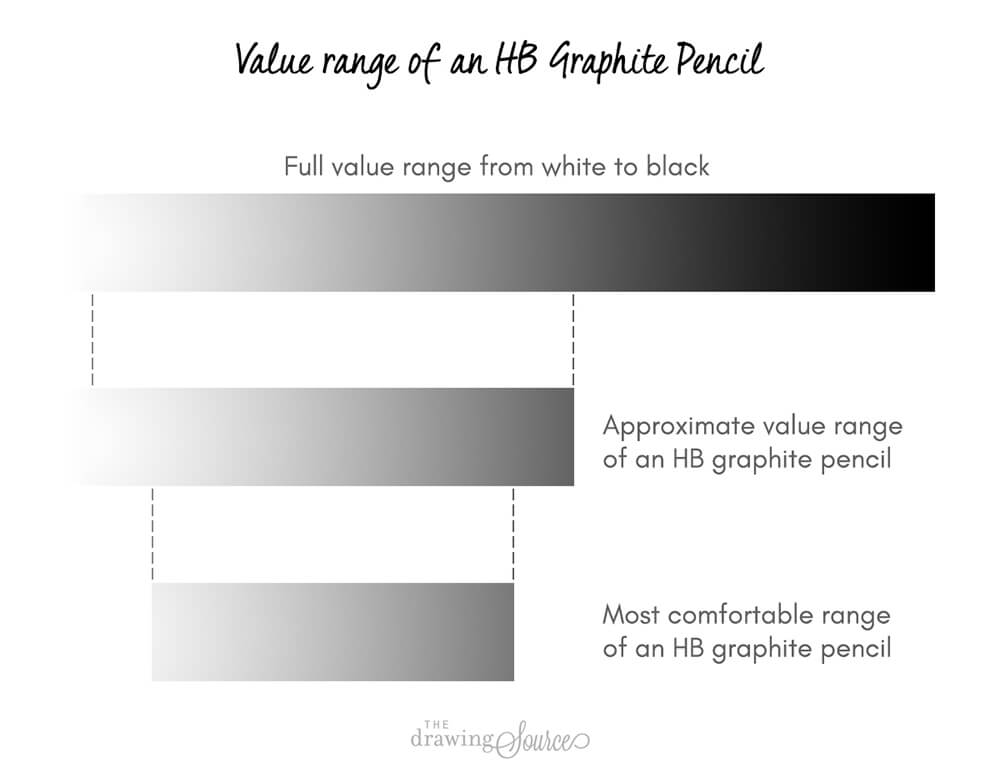
In the diagram above, you can undergo that the HB pencil can create a certain segment of values. Within its value range is the 'most comfortable' range that it lavatory create. This means that you can extend its value range by using a kneaded eraser to brighten values, surgery layering your pencil marks to darken values, but IT will take more effort to do that than to simply use a pencil that comfortably creates the value that you need.
The harder the pencil, the lighter the range of values that information technology creates.
The softer the pencil, the darker the range of values that it creates.
(This is the case for charcoal equally well arsenic graphite.)
As you can see in the image down the stairs, the darkness of graphite pencils varies from Very light grey (9H) to almost pitch black (9B).
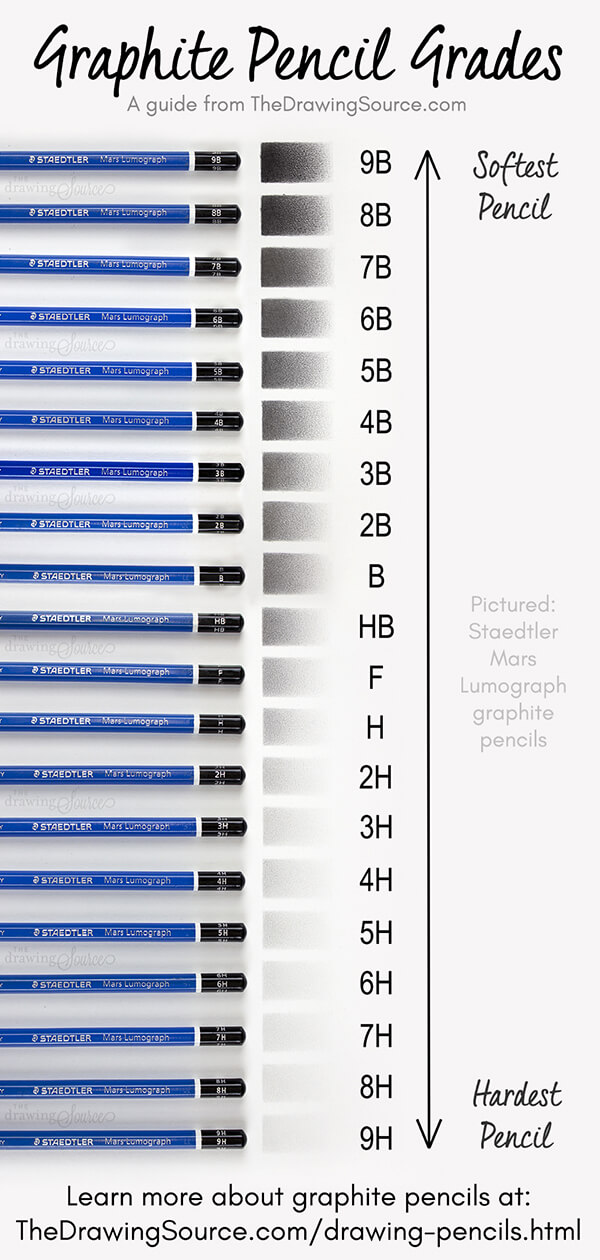
Army of the Righteou's equivalence the value ranges of two more graphite pencil grades. In the image downstairs, the top gradation was tired with a 2H graphite pencil. It ranges from the darkest practicable value the 2H can create to the lightest possible value that it can buoy make.
The bottom of the inning grade was haggard with a 4B black lead pencil, and ranges from the darkest realizable value the 4B can create to the lightest appreciate it can create. (I used Staedtler Mars Lumograph graphite pencils for both gradations.)
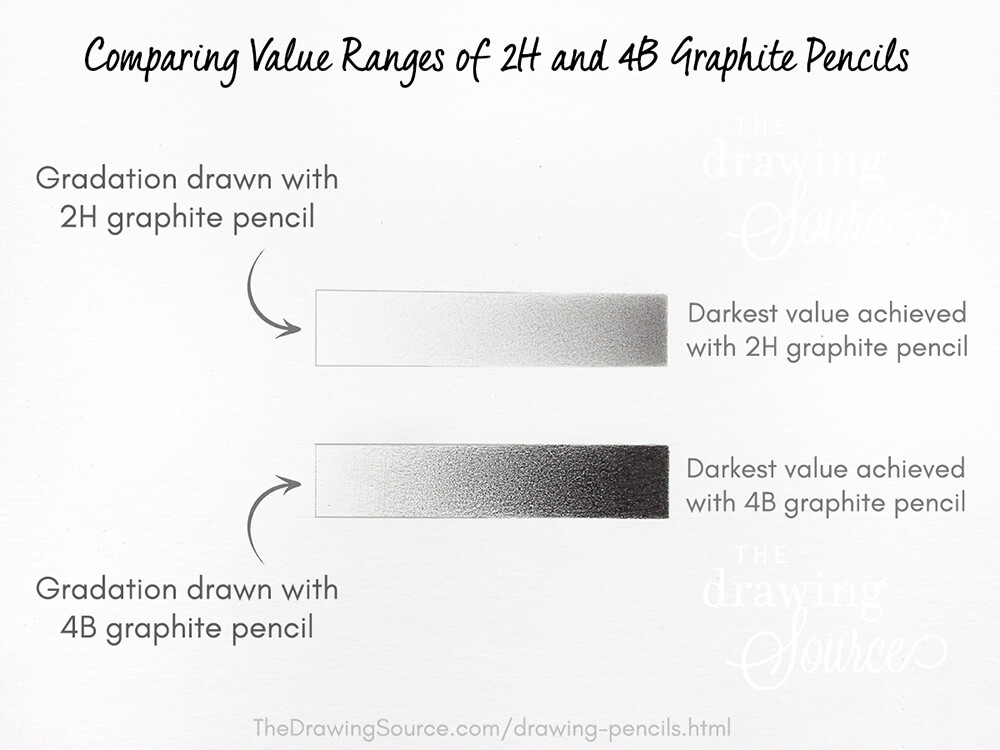
How act these gradations liken?
First, notice the vast difference in the range of values created by the 2H and 4B. The 2H potty well make from a value 2 to a value 3 or 4 on the rate scale, while the 4B can create from a value 6 through 8. I had to employ my kneaded eraser to create the lighter values of the 4B gradation, while information technology was almost effortless to habit the 2H to gradate into the bloodless of the newspaper publisher. Notice how much smoother the 2H gradation appears as well, patc you can see to a greater extent of the paper texture in the 4B grade.
![]()
B O N U S : What grade of pencil should you pull out with?
Discover out in this unpaid downloadable manoeuver!
(Plus, access the Free Members-Merely Drawing Resource Library, and receive a weekly newssheet.)
![]()
How does the grade of a drawing pencil affect air quality?
The hardest pencils make sharper, lighter, thinner lines, while the softest pencils create softer, darker, thicker lines. (Of course, this depends on the keenness of your pencil Eastern Samoa well, but generally talking - it is much easier to produce a sharper line with a hard pencil, and a softer line with a subdued pencil.)
Do you need the whole place of graphite pencils, from 9H to 9B?
No, it's non a necessity, but a matter of personal preference and skill level.
When I work with graphite, I usually have an HB, 2B, and a 4B. Along the occasion that my drawing requires a very dark value, I May also use a 6B (though I try to avoid them, American Samoa the darker the graphite pencil, the more it will reflect light and produce glare - but I'll discuss that in a later section of the article).
If you are new to drawing and are developing the sensitivity of your hand, you Crataegus oxycantha want to supply a few harder pencils, such American Samoa a 2H, to make it easier to draw the lightest values in your drawing.
Types of Graphite Drawing Pencils
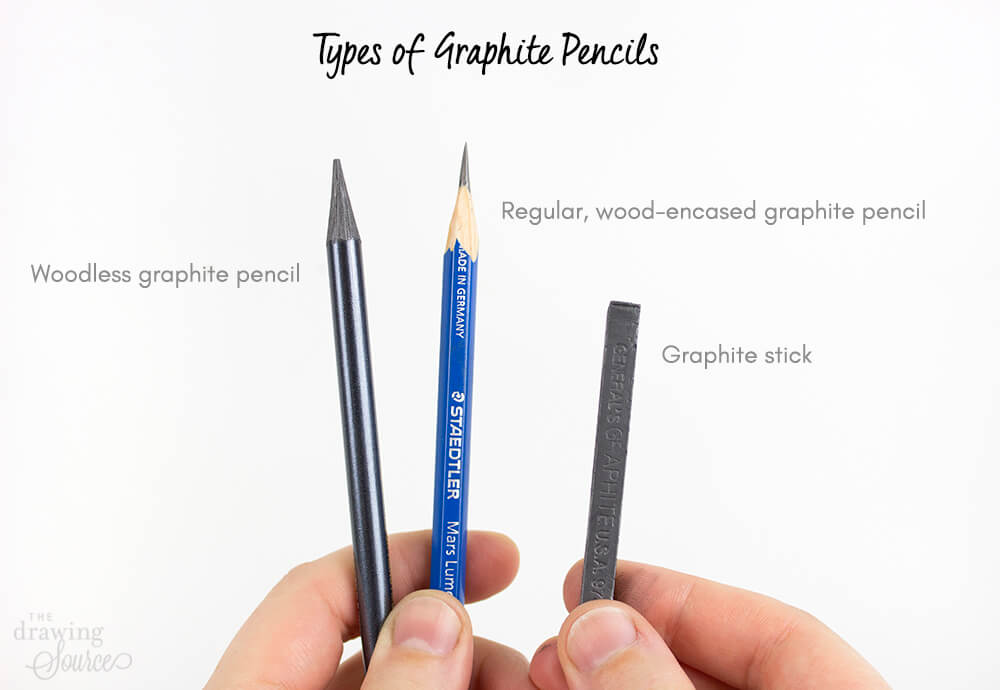
Graphite pencils come with in some forms.
- They can equal encased in wood - these are the most common form, pictured above.
These graphite pencils are ready-made of a mixture of graphite powder and cadaver filler. The ratio of the 2 determines what class, or hardness, the pencil is. The more filler - the harder the pencil. - They can be in pencil shape but "woodless"
- They can be in stick form
Brands of graphite: I tend to use Staedtler Mars Lumograph pencils, but other brands such as Derwent and Faber-Castell work merely fine as well.
Working with Graphite Pencils
The application of graphite on paper is smoother than charcoal, and easier to gain control of. It can be very comfortable and enjoyable to work with, particularly when paired with a even draught paper .
Because of this, I often advocate that beginners attracter with graphite to build confidence and go through before moving connected to charcoal pencils.
Keep in judgement that graphite has a metallic shininess.
The shine, or glare, send away be very unmistakable when you stand at an angle to a depiction drawn in graphite, such as the one below:
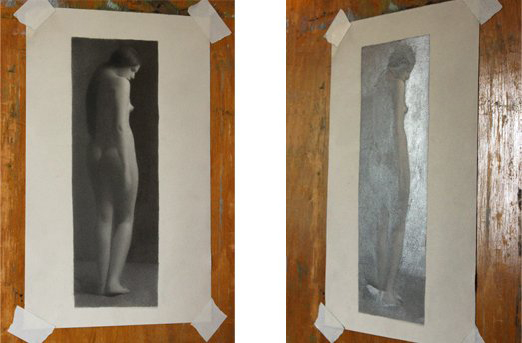
As you can see, the luster becomes more apparent where there are darker values. So, the darker the tones in your drawing, the more they will reflect light and produce glare. This can live particularly irksome when trying to photograph graphite drawings.
While there are ways to belittle graphite glare, it is ultimately an ineluctable quality of the medium. If you experiment with graphite and find that the glare is also much for you, Don't fight it. You will lose. If it bothers you besides some, just don''t use it! Instead, use one of the many drawing pencils available to you that get into''t naturally take in a shiny, metallic quality.
(I actually derelict the above drawing because I was frustrated with the glare. Lesson learned! Graphite is advisable used for lighter value drawings. Notice that the lightest areas in the drawing above are non producing any glower!)
Always endeavor to cultivate with your materials, not against them. This will result in a much more enjoyable drawing process for you, as fountainhead as a better closing ensue!
Tips for Minimizing Graphite Spotlight
- As you can see in the image above: the lighter the area, the less glare will be produced. Choose to bring up in graphite when you are drawing a lighter image.
- If you must use graphite for the cheerless areas of your drawing, rather of pressing harder with the pencil, lento layer the graphite to darken the expanse.
Charcoal Pencils
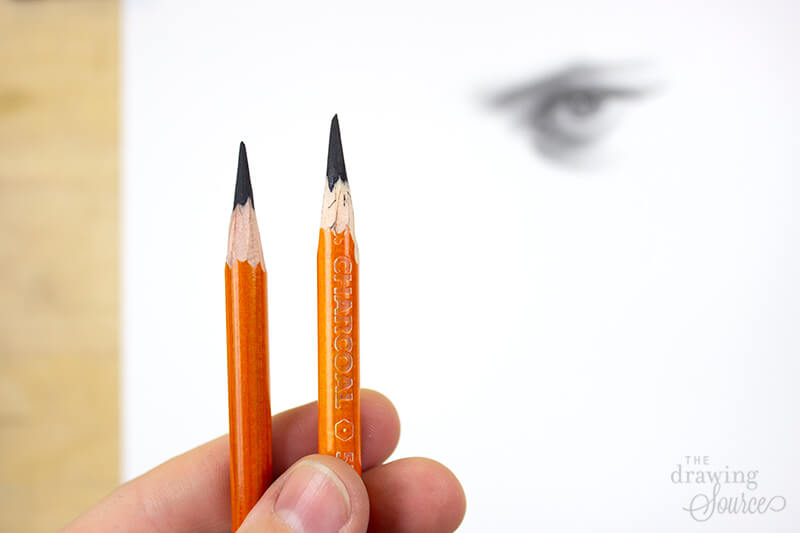 Pictured above: Generals Charcoal Pencils
Pictured above: Generals Charcoal Pencils
Oxford grey pencils consist of fusain pulverisation motley with a gum ring-binder. This concoction is then compressed into sticks or encased in wood. As with graphite, the amount of binder used regulates the degree of unfeelingness of the pencil. The more binder used, the harder the rate of the pencil.
The hardness of charcoal pencils normally ranges from Hemoglobin to 6B (from hardest to softest). A few brands decease a mistreat further and make 2H pencils, but I personally don''t use them (I find that they oft scratch my drawing composition rather than leave a diplomatical Deutsche Mark).
If you are going to work with charcoal pencils, I paint a picture that you buy an HB, 2B, 4B and a 6B, by a stigmatize known as General's. (Read about what I look for in charcoal pencil brands and how to compare them therein clause!)
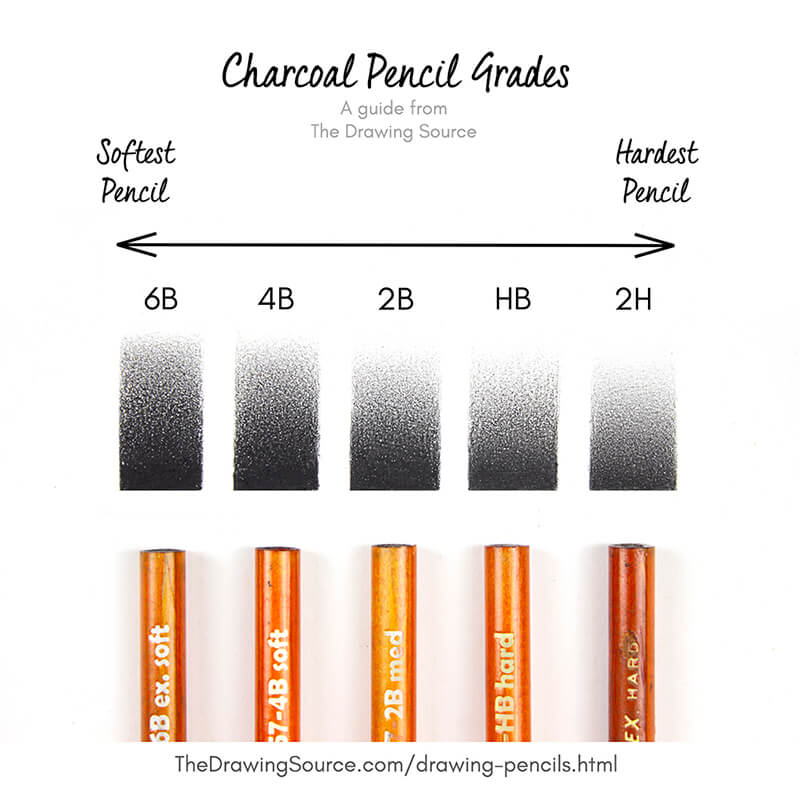
You may come across charcoal pencils by other brands that are classified simply as 'mushy, medium, and herculean' or 'light, medium, an dark'. I wear't use these because I find that pencils using the 'mushy, medium, and hard' classifications tend to glucinium little consistent and predictable than the General's pencils.
General's pencils also have a wider range. For example, a General's HB tends to glucinium harder (and therefore easier to make lighter First Baron Marks of Broughton with) than a 'hard' charcoal gray pencil. If you must utilize wood coal drawing pencils labeled as 'soft, medium and hard':
The 'hushed' pencil is comparable to a 6B
The 'mass medium' pencil is comparable a 2B or 4B
The 'vexed' pencil is comparable an HB
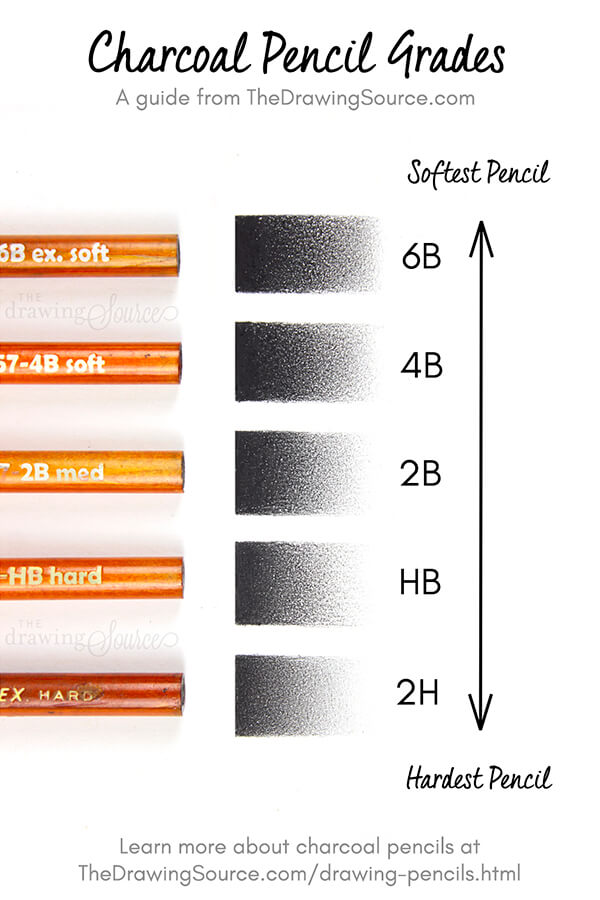
Willow and Vine Charcoal grey Sticks
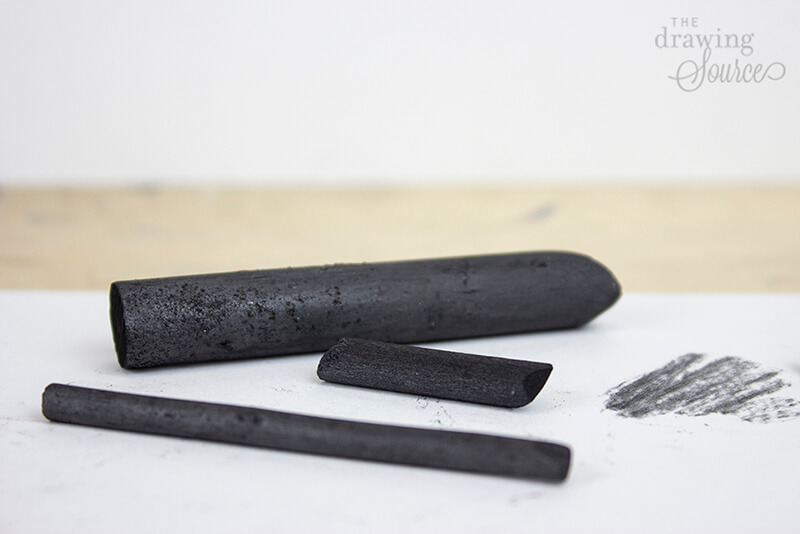 Vine charcoal sticks
Vine charcoal sticks
Literally burnt twigs, willow tree and vine oxford gray sticks are uncompressed charcoal. As conflicting to compressed charcoal (which is found in regular charcoal pencils), uncompressed charcoal is much softer, lighter, and easier to spread and erase. In fact, information technology lifts cancelled the paper so easily that you actually suffer to be careful not to disturb information technology!
Willow and vine charcoal sticks are particularly useful tools for pick in and evening knocked out large economic value masses, especially when paired with a soft stand up brush. You can too use information technology to tone your own paper, as I did for the sketches below:
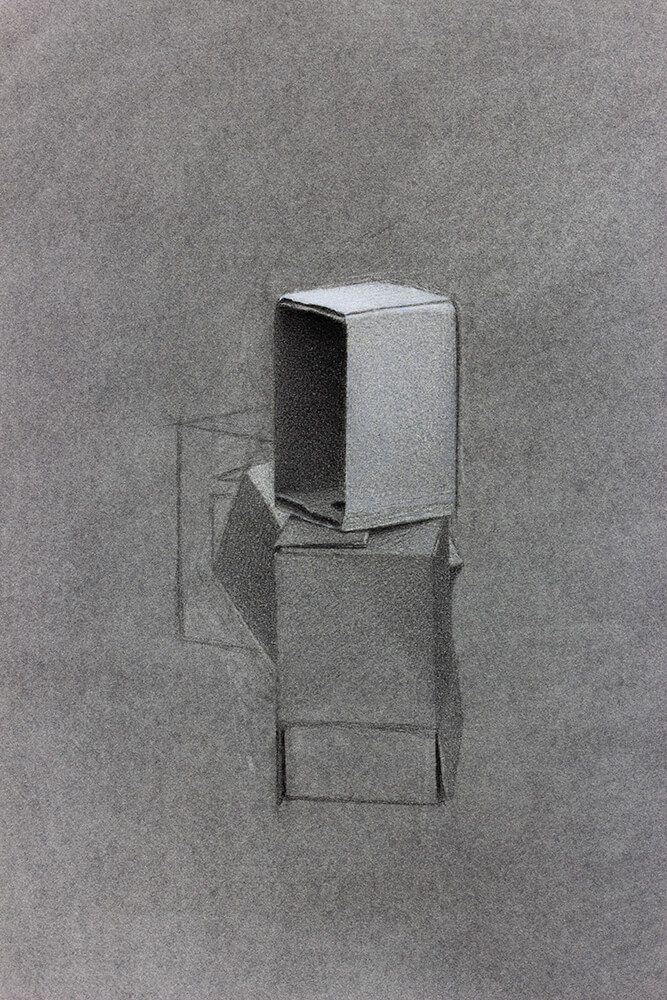
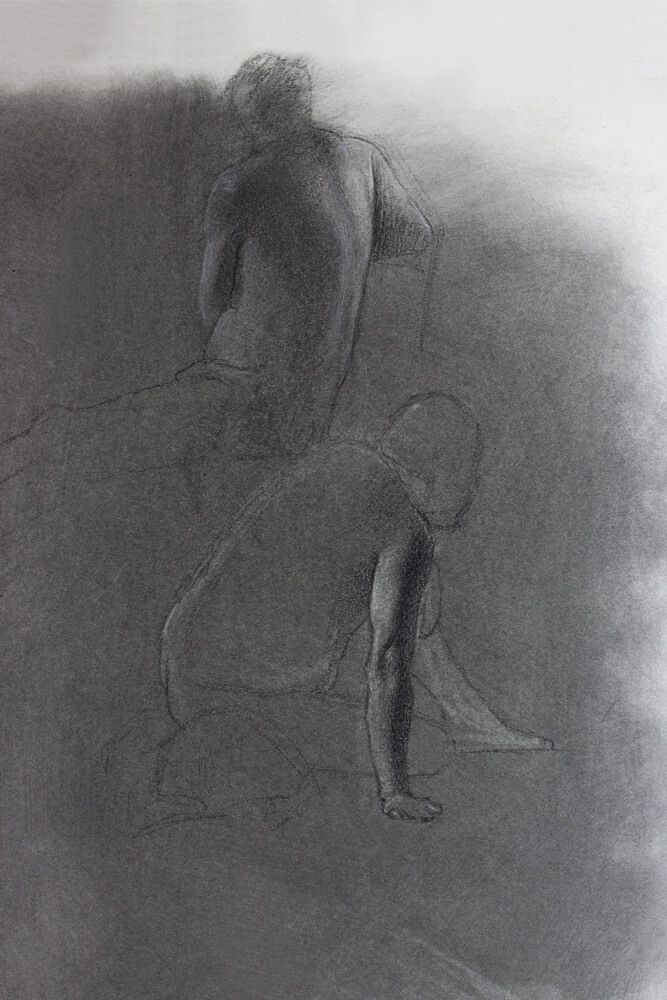
Above: sketches on tonal paper exploitation a combination of black and white oxford grey drawing pencils.
Black lead vs. Wood coal
The drawing pencils that you choose depend on many factors. One pencil is not "better" than another: they every last have different characteristics that are appropriate for different kinds of drawings. You bequeath learn to choose the right intermediate for your drawings as you experience the qualities of the different drawing pencils, and figure out what kind of lottery you want to make.
Having said that, here are some in favor of's and con's of graphite vs. charcoal:
Graphite
- (Favoring) easier to work with because the application of plumbago in writing is sande than that of wood coal
- (Con) potty reflect light, creating graphite glare or shine (causing values to seem lighter than they actually are)
- (Con) does not dim to sable as well as charcoal
Charcoal
- (Con) requires Sir Thomas More science to work with (IT is more than difficult to draw flimsy lines and smooth, even values with charcoal pencils)
- (In favour of) absorbs light - no 'glare'!
- (Pro) darkens to a pitch unfortunate, allowing us to create a wider range of values and higher contrast images
- (Pro) versatile: can be cooperative with white charcoal
When to Consumption Charcoal Pencils:
- When you need a sounding tramp of values, from white to pitch black. Charcoal darkens to pitch black, allowing you to create a wider range of values in your drawing. Graphite simply does not darken to the same coal black American Samoa charcoal does.
- When creating a 'low value key' drawing: a drafting where most of the values are between values 5 and 9 on the value scale.
- When you lack to merge it with a white drawing pencil. Charcoal-gray is a rattling varied medium. Information technology can be used by itself, or combined with a white drawing pencil to give your drawing different looks and variations in temperature. Here are three of my favorite techniques for combining charcoal with white.
- When you dislike the radiance that graphite creates. Much artists hump the graphite shine, others are neutral, and others quite disapproval it. I in person don't bon it, and usually only employment graphite when creating drawings that consist for the most part of lighter values.
When to Wont Graphite Pencils:
- When creating a 'high Francis Scott Key' lottery: a drawing that consists mostly of lighter values. As you saw earlier in the article, lighter values produce less black lead glare.
- When you want a sande drawing experience. The application of graphite happening paper is emphatically smoother than that of fusain. It is easier to draw lightly with graphite, and to shade smoothly and evenly. (You can for sure learn to do the same with charcoal, simply it volition take considerably more practice.)
Can you combine graphite and charcoal?
I see what you're thinking ... you deprivation the best of some worlds! This is actually a popular question that I receive.
Graphite and charcoal do not level on top of apiece other very well. Yet, if you are studious, you can use graphite next to charcoal. For example, you can use graphite for lighter areas of your lottery, and create a subtle gradation that 'turns into' charcoal (again, not layering one on top of the new, but making trustworthy that one is right next to the other).
This is an advanced technique that I suggest using once you are comfortable victimization graphite and charcoal drawing pencils individually.
Conclusion
The best way to irritate know what drawing pencils you prefer is to work with both! An excellent exercise to compare the properties of these two pencil types is to pass over the same subject matter to using graphite and then charcoal. Why not do this with me in my Practical Drawing 101 course, patc learning the essential skills and concepts of representational draftsmanship?!
If you have any questions about these supplies, you are receive to email Pine Tree State at marina@thedrawingsource.com
Happy Drafting!
![]()
![]()
B O N U S : What grad of pencil should you thread with?
Find out in this free downloadable pass over!
(Plus, access the Free Members-Only Draft Resource Subroutine library, and experience a weekly newsletter.)
![]()
Enjoyed this page? Please share it!
Percentage buttons and pinnable images on a lower floor:
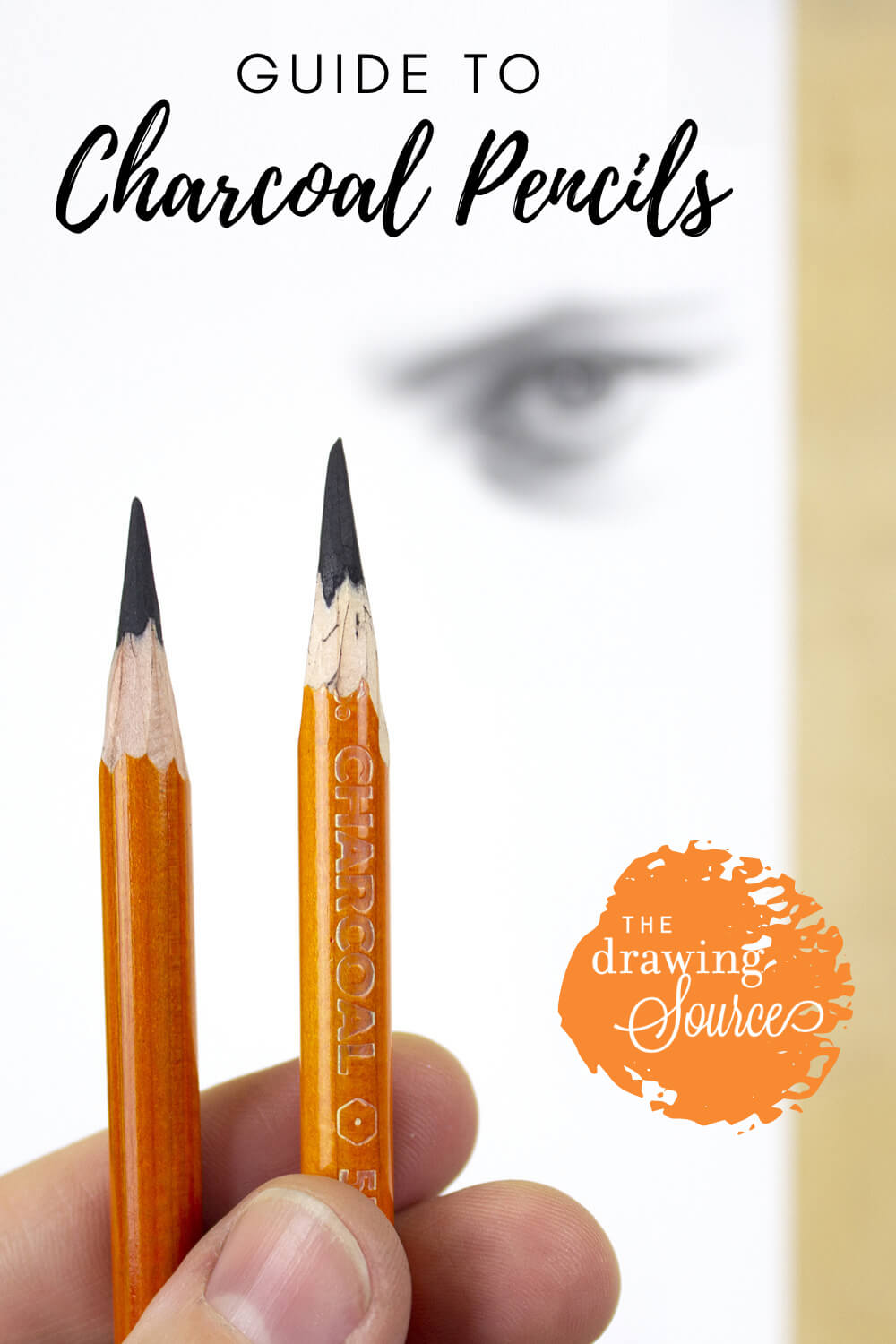
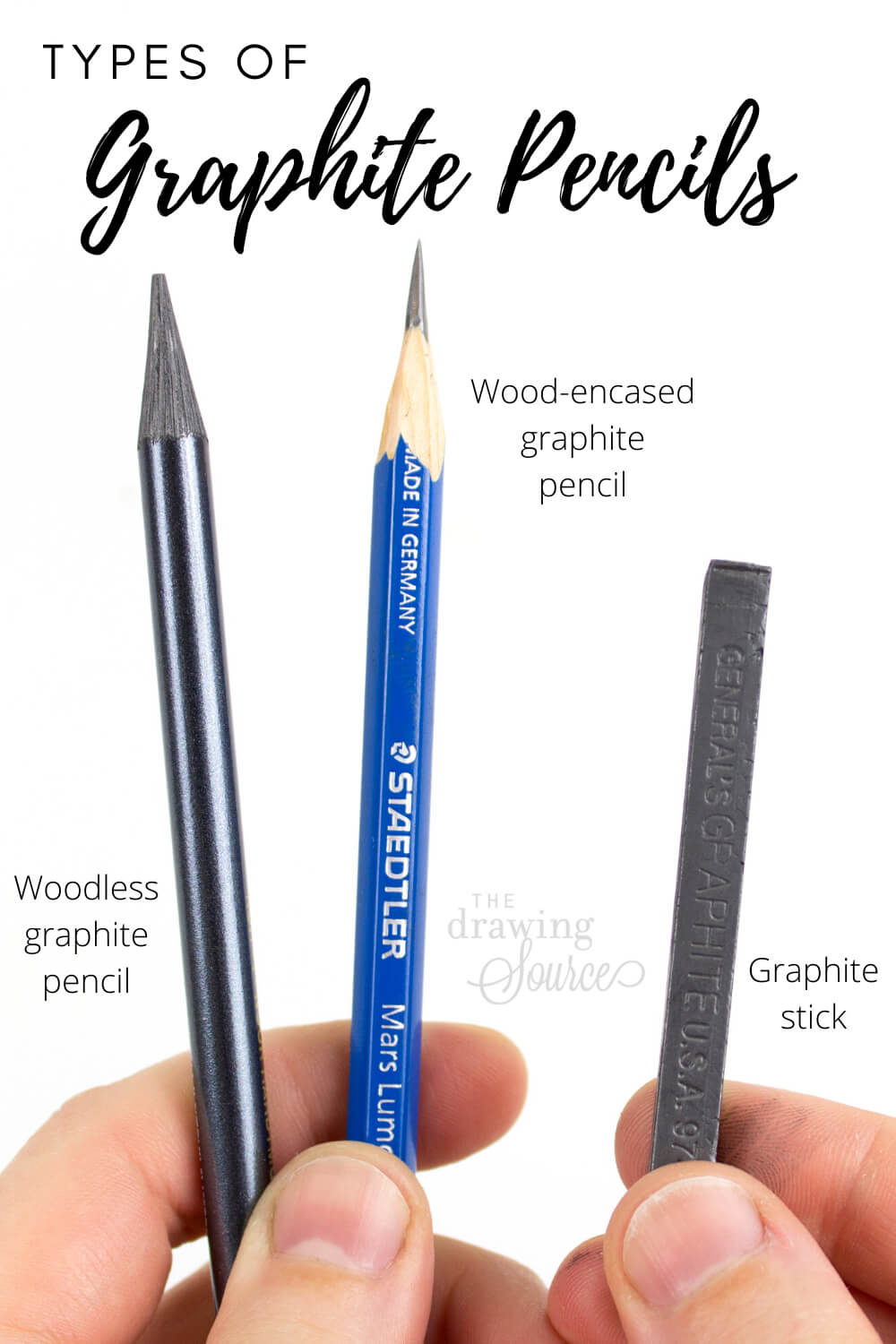
Related Pages
If you enjoyed this page happening drafting pencils, you may also delight ...
How to Sharpen Drawing Pencils
How to Hold and Control Your Draft Pencil
3 Ways to Use White Charcoal Pencils
How to Make Toned Paper
Return to Drawing Supplies from Drawing Pencils
Return to the Homepage from Draught Pencils
Great Tools for Graphite Drawing
Source: https://www.thedrawingsource.com/drawing-pencils.html
0 Response to "Great Tools for Graphite Drawing"
Post a Comment